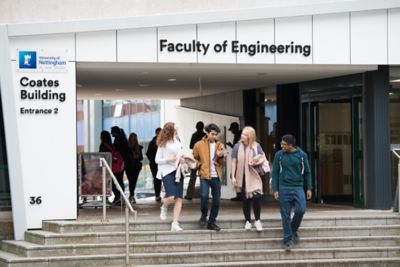Life after graduation: shaping a successful career
Read about Matt, a recent graduate, and about his experience studying architectural environment engineering at the University of Nottingham

After graduating from university, Matt came second in the Civil Institute of Building Service Engineers (CIBSE) Young Engineer Awards. Now he has a successful career at AECOM as a Mechanical Engineer and is inspiring the engineers of the future.
What attracted you to studying architectural environment engineering?
Honestly, it was a bit of an accident. At college I didn’t really know what I wanted to do, but I was studying a mix of maths, physics and graphic design. My careers team recommended that I look into a career in architecture, and it was something that I was quite interested in.
I applied to Nottingham for the MEng architecture course, but unfortunately, I didn’t get the grades required. Luckily, based on my personal statement the team at Nottingham offered me a spot on the Architectural Environment Engineering course that was an even better fit for what I was interested in!
Why did you choose to study at the University of Nottingham?
For me it was mainly the campus. The Nottingham campus is lovely, you have this little pocket of greenery pretty central in a major city. I always found that there was a buzz on campus and the facilities were also very nice.
Nottingham city is also a lovely place to live. It’s central in the country so was pretty easy to get everywhere, and the city itself is very vibrant with lots of nightlife and shopping.

As someone who has always been interested in what I can do to fight climate change, this degree and job has set me up perfectly to make my mark on an industry which contributes towards 40% of carbon emissions in the UK.
Matt Dickenson
Architecural Enviornment Engineering graduate

Matt Dickenson, Architectural Environment Engineering graduate
How did your time at university shape your career?
The course focuses on the fundamentals, which is a real strength in my opinion. Not only does it keep your options flexible as you can transition into other fields, but it also gives you an excellent foundation to move forwards as an engineer. Engineering is all about problem solving, so knowing the rules you are playing with is invaluable.
The course also focuses on team projects, which will be essential going forwards. In industry, every project you work on you will be part of the team. These large design teams can include architects, structural engineers, the client, manufacturers, and contractors, so developing clear communication and presentation skills sets you up well for the future.

An industry placement is highly recommended – it helps show that you are keen, puts all your education for the following year in context and gives you the edge in employment afterwards.
Matt Dickenson
Architecural Enviornment Engineering graduate
Tell us about your job at AECOM
I undertook a summer placement at AECOM during my time on the course and ended up re-joining the team after I graduated in 2019. I work as a mechanical engineer in the building services sector, where I lead project teams in designing heating, ventilation, and air conditioning systems for a variety of office and residential developments in and around London.

Not only does it keep your options flexible as you can transition into other fields if you decide to go that way, but it also gives you an excellent foundation to move forwards as an engineer.
Matt Dickenson
Architecural Enviornment Engineering graduate